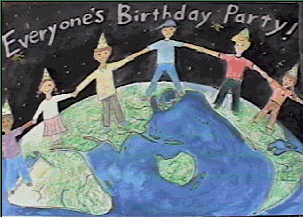 Lesson One (pictures 1 through 3 of the
storyboard) A Birthday Party: know that everyone has a birthday, even a star.
Lesson One (pictures 1 through 3 of the
storyboard) A Birthday Party: know that everyone has a birthday, even a star.
excerpted from the report (translated from Japanese): Primary and secondary school curriculum and projects for team-teaching with an AET: connecting international understanding, multi-media, environmental studies, and English-as-a-second language
Everyone's Birthday Party gives a simple, adventurous view of the history of space and life on earth as a series of inter-connected birthdays. The story is told through the imaginary diary of a six year old boy who just had a birthday party. The boy notices that there are the same number of people at his party as his age, he gives a year to each person to divide his age. This method of dividing time into the number of people in the room is used again when the brightest star takes the kids on a birthday adventure to the "Big Birthdays Room." The star divides his age between thirty people -- the six kids and twenty-four space spirits in the room -- to show how everyone's birthday is connected. The star then zooms-in on the last person representing the last 500 million years. Students learn to divide this time-span on our upper body and review the story of land-life on earth. Humans come into the birthday story in the last centimeter on the students wrists. We zoom-in even further on this story to see the story of human migrations to all parts of world during the last five hundred thousand years. The story pays special attention to changes in skin color and eye shape depending on the new environments people encountered.Å@ The story is divided into three parts and can be taught in three or four hours including word recognition games.
Purpose and class outline for four class hours
Objectives:
 Lesson One (pictures 1 through 3 of the
storyboard) A Birthday Party: know that everyone has a birthday, even a star.
Lesson One (pictures 1 through 3 of the
storyboard) A Birthday Party: know that everyone has a birthday, even a star.
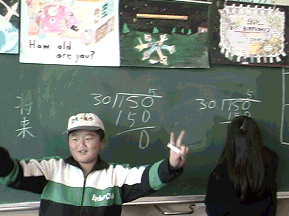
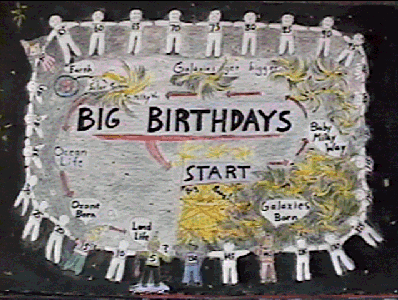 Lesson Two
(Pictures 4 and 5) Big Birthday Room: we take a "birthday adventure" to see the
connections between birthdays in space and life on earth.
Lesson Two
(Pictures 4 and 5) Big Birthday Room: we take a "birthday adventure" to see the
connections between birthdays in space and life on earth.
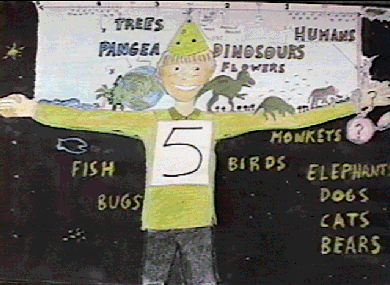 By the 28th person, we see the birth of the Ozone shield around the earth
which allows life to be born on land. To get to the 28th person, we practice the
English words: Twenty-second, Twenty-third, . . . Twenty-eighth, Ozone, Land Life)
By the 28th person, we see the birth of the Ozone shield around the earth
which allows life to be born on land. To get to the 28th person, we practice the
English words: Twenty-second, Twenty-third, . . . Twenty-eighth, Ozone, Land Life)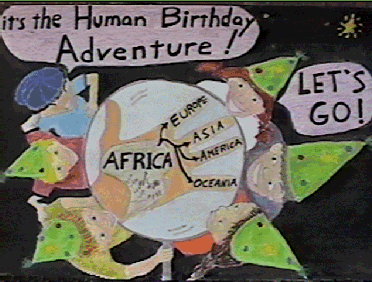 Lesson 3 (pictures 6 through 11)
"Human Birthday Adventure" (The adventure of human birthdays: he story of how
the family of humans were born and came to migrate around the world.
Lesson 3 (pictures 6 through 11)
"Human Birthday Adventure" (The adventure of human birthdays: he story of how
the family of humans were born and came to migrate around the world.
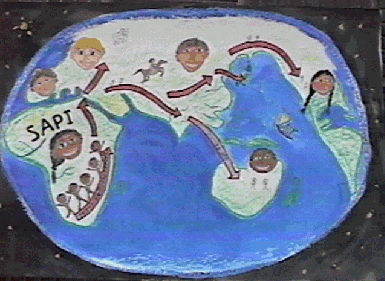 At the end of the last ice-age, big brothers Peking and Java, and little
brother Neanda leave home for Asia and Europe and never come back (picture #9).
At the end of the last ice-age, big brothers Peking and Java, and little
brother Neanda leave home for Asia and Europe and never come back (picture #9).Lesson 4 (Review of the story) Students give their opinions about the story, and we play KARUTA and/or Bingo to review the English words and phrases.
Student Survey Results
(9 months after the lesson)
Lower Primary Grades
Nakamichi-Kita Primary School, third grade (actual class second grade)
1) What did you think of the lesson?
I couldn't believe that the star is 150 billion years old (7 students). I realized that everyone's birthday is connected (2). I could understood birthdays (2). I was amazed (2). I could understand many things (2). It was fun (1). I didn't' understand, but it was interesting (1). I could understand the star's age (1). It was fun asking the star how old he is (1). The "Big Birthdays Room" filled aliens was fun (1). I could understand how long there has been life on earth (1). I enjoyed the birthday song (1). I learned how to ask someone how old he is, and ask a star how old he is (1). It was fun studying about birthdays (1).
2) What was the best part?
The birthday party (7 students). Understanding the star's age (2). The pictures were good and it was fun (2). I liked the picture of the body with animals on it (2). I could understand more about stars (2). The English KARUTA game (2). I could understand the interesting birthday parts (1). It was good that you could make it all interesting (1). It was a fun story and I want to hear it again (1). The star's birthday party was fun (1). When the star told everyone his age (1).
Nakamichi-Minami Primary School, fourth grade (actual class third grade), 29 students
1) What did you think of the lesson?
I couldn't believe the star was 15 billion years old. I was surprised and though it was great! (11 students). It was fun and interesting (4). I thought it was a very good party (1). I thought that my age (10 years) was very different from the star's age (15 billion years) (1). The birthday adventure was interesting (1). This was the first time I understood the history of human birthdays (1). I could understand how our birthdays are connected (1). I realized that all living things have birthdays (1). I thought to myself many times, "that's how it is!" (1). I'd like to go one time on a birthday adventure too (1). I'd like to live 15 billion years like a star (1).
2) What was the best part?
The star is 15 billion years old (4 students). The birthday party (3). It was interesting to see so many things on the birthday adventure (3). I could hear English (3). [The "Big Birthdays Room"] where everyone's hands were joined (2). The whole storyboard (2). Hearing the story (1). When the star joined the birthday party (1).
Nakamichi-Kita Primary School, fourth grade (actual class third grade), 27 students
1) What did you think of the lesson?
It was good, fun, and interesting (10 students). I was amazed that the star was 15 billion years old (5). The party and all the different stories in the party were fun (2). The dinosaurs' birthday was especially interesting (1). I thought that it was an interesting party (1). I enjoyed asking the star how old he is (1). I thought that the star is REALLY an old man if he is 15 billion years old. It was good to know how long the dinosaurs were alive (1). I got real excited by the story (1).
2) What was the best part?
Joe's story (8). The [Big Birthdays Room] where [its] everyone's birthday party (5). The star is 15 billion years old (8). The pictures of the earth (3). I thought that birthdays are fun, so this story was fun (1). Drawing pictures (1). When we asked the star how old he is (1). It was interesting that the star gets older (1). When everyone was playing [outside] (1).
Toyotomi Primary School, fourth grade (actual class third grade), 35 students
1) What did you think of the lesson?
I was amazed that a star is 15 billion years old (18). It was fun and interesting (7). I could understand the star's age (3). It was fun to sing a song (2). It was interesting to hear an English story (1). I could understand how to ask the age of someone (1). I realized that the stars were here long before I was born (1). I could really understand about space (1). I thought that the story was very mysterious (1).
2) What was the best part?
Understanding the star's age (7). It was interesting to do the class in the style of a birthday party (6). The Big Birthday Room in space where it was everyone's birthday party (4). The song was fun (3). The story (3). The KARUTA English game (2). The pictures (2). The Birthday Adventure(1). Understanding more about space (1). Remembering English (1).
Upper Primary Grades
Toyotomi Primary School, fifth grade--homeroom #2, (actual class fourth grade), 18 students
1)What did you think of the lesson?
I was amazed that the star was 15 billion years old (6). I wondered if stars can get old (2). It was fun (3). I thought that having a birthday was fun (1). I wondered if stars are alive (1). I'd like to live 15 billion years (1). Stars live a lot longer than people (1). That was the first time I'd heard the story (1). It was good to sing a fun song (1). The Birthday Party was fun because it was Everyone's party (1). I could understand about birthdays more (1). It was great study (1). I could understand English (1). The story board was good (1).
2) What was the best part?
The birthday (1). It happened to be my birthday too, so it was really fun to celebrate together (1). I'd like to talk to a star too (1). It was good to hear the story (1). We don't hear stories like this often, so it was good (8). The star's birthday adventure stories (1). The Big Birthdays Room (1). The pictures (1). The story-board (1).
Nakamichi-Kita primary school sixth grade--homeroom #1, sixth grade (actual class fifth grade), 20 students
1) What did you think of the lesson?
I thought that it was amazing that the star was 15 billion years old (5). After the party, the Birthday Adventure with the star was interesting, fun, and amazing (4). I thought that when my birthday comes, I'm going to ask a star the same question (2). It would be great if we could really talk to stars (2). During the birthday adventure after the party, I learned a lot of things I did not know (1). The story made me wish my birthday would come soon (1). I could understand the Big Bang and many other things. Using my body to see when humans were born was interesting (1).
2) What was the best part?
Hearing that the star was 15 billion years old (3). It was interesting to use the storyboard to see how our birthdays are connected with a star (3). The English song (3). The Birthday Adventure (2). When everyone announced their birthdays (2). Everything about birthdays (1). When everyone was at the birthday party, including the dog (1). Learning English (1). Dividing our body into parts to see how birthdays are connected (1).